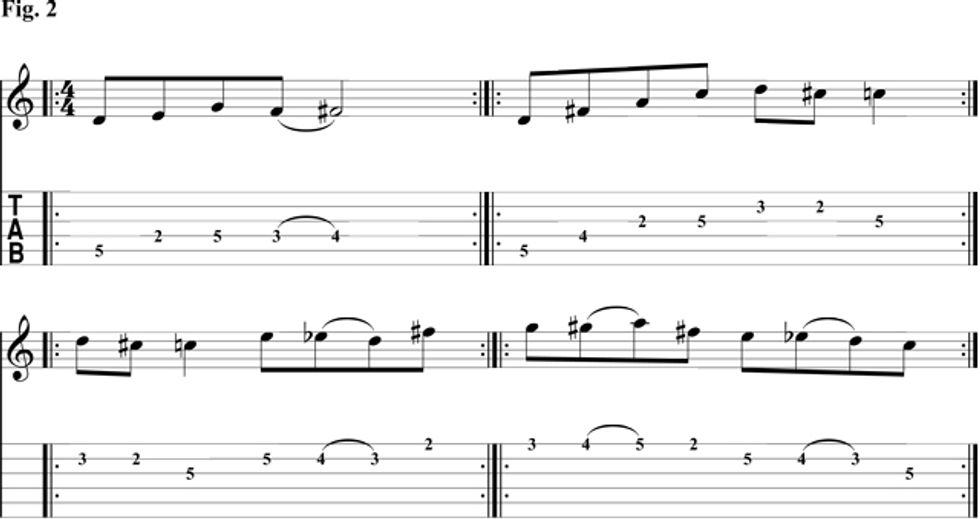Chops: Intermediate
Theory: Intermediate
Lesson Overview:
• Learn how to effectively add “outside” notes to your blues phrases.
• Understand the difference between a neighbor tone and an enclosure.
• Create ear-twisting lines with chord tones on strong beats.
Click here to download a printable PDF of this lesson's notation.
As far back as I can remember, I’ve always had a soft spot for chromaticism and playing outside. From the bop lines of Mike Stern to the bluesy soul of Robben Ford and the fluid legato runs of Brett Garsed, there was always something incredibly ear-catching in these lines. A big part of the appeal was the mystery surrounding these lines that wasn’t present in a lot of the music I’d been listening to at that point.
Coming from the Greek word for color (chroma), the term chromatic can be seen as a scale that contains all colors. There are a variety of ways to play outside of the key you’re in. Some people like to substitute various scales in place of the “correct” one or imagine a series of chord changes that aren’t there to create some harmonic movement. Some like to use parallel motifs, while others just like to play utter nonsense. In the future we’ll probably explore some of these approaches in detail, but today let’s look at passing tones and neighbor tones.
The first example (Fig. 1) shows the D Mixolydian scale in position three (see my previous lesson for CAGED terminology) and then the same scale played with a “filling in the blanks” approach. There’s no real structure to this in terms of where the chromatic notes fall in the bar, but similar ideas work to great effect in the playing of progressive rockers like John Petrucci. We want some organization in our outside sounds, so take a look at the four fragments below.
In the first measure of Fig. 2, you can see one chromatic tone (the F natural—3rd fret, 4th string). This note creates tension and then moves up a half-step to F#, a chord tone. This approach is often called a neighbor tone because we’re playing a chromatic note a half-step away from a diatonic note (usually a chord tone).
You could expand on this idea by trying to approach any note in an arpeggio from a note above or below. It’s also worth noticing where the note falls in the phrase—on a weak beat. By this I mean that it’s not where we would tap our foot or feel the pulse. We’re creating tension at a weak point and then resolving it on a strong beat.
The second measure also contains just one outside note (C#—2nd fret, 2nd string). As before, you’ll notice that it appears on a weak beat. After an ascending D7 arpeggio, we move from the root (D) down chromatically to the b7 (D–C#–C). This is a perfect example of a chromatic passing tone. In this case, you move from one chord tone to another, but fill in the blank space for color and momentum.
The third measure contains two examples of chromatic passing tones, the first targeting the b7 (as in the previous example) and the second targeting the root (E–Eb–D). As with the previous two examples, you’ll notice that all outside tones fall on weak beats.
There are two four-note phrases in the third measure—one targeting the 5 and one targeting the root—with the passing tones on weak beats. Really, you’re going to want to dig deeply into the phrasing of guys like Mike Stern to expand on these ideas. Once you’ve learned all the basic phrases and “rules” regarding chromaticism, you’ll find you don’t think about it any more and your lines will just take form with a strong harmonic sound.
Fig. 3 is our first real lick. Now we’re playing 16th-notes with a swing feel over a D7 chord and you’ll really start to see the reason we try to put chromatic notes on weaker beats. As before, this line follows all of the rules we laid out—all passing tones occur on weak beats. When you play with a swing feel, the strong notes are naturally longer than the weak notes and this creates a serious sense of forward motion and harmonic strength.
We feature another chromatic idea, referred to as an enclosure, in Fig. 4. If you look at the second beat you’ll notice the notes G–F–F#, with F# being the note that’s targeted. In order to place the target note on a strong beat, I play a note above the target, then one below it, and finally resolve to the intended note. Try spotting all the chromatic notes in this lick and label them as either neighbor tones, passing tones, or enclosures.
Fig. 5 is based out of position four and is rich in encirclement. First we target the 3 (F# on beat 2), then the b7 (C on beat 3), and the 3 again in the second measure. There are also Cmaj7 and Am7 arpeggios here, and both are common diatonic arpeggios to use over a D7. Lastly, Fig. 6 is a hip little phrase that uses most of the ideas presented in this lesson. See if you can spot them and identify where they fall in the bar.
As with anything, it will take a while for this technique to become second nature, but once you’re there, you’ll be able to slip some more jazz-influenced lines into your classic blues phrases. It doesn’t have to be the main feature of your playing, but it’s a great tool to have at your disposal.
D7 Backing Track
 Levi Clay
Levi ClayLevi Clay is a London-based guitar player, teacher, and transcriber. His unique approach to learning keeps him in constant demand from students the world over, and his expertise as a transcriber has introduced his work to a whole new audience. For more information, check out leviclay.com.
















![Rig Rundown: Russian Circles’ Mike Sullivan [2025]](https://www.premierguitar.com/media-library/youtube.jpg?id=62303631&width=1245&height=700&quality=70&coordinates=0%2C0%2C0%2C0)














